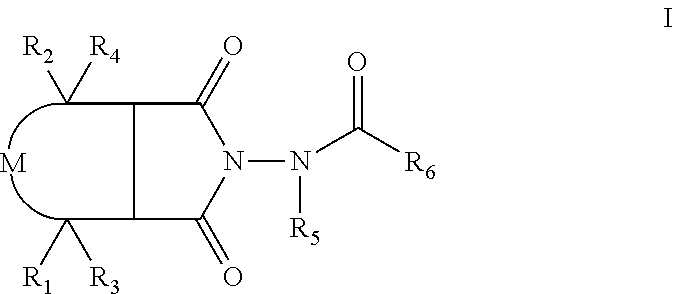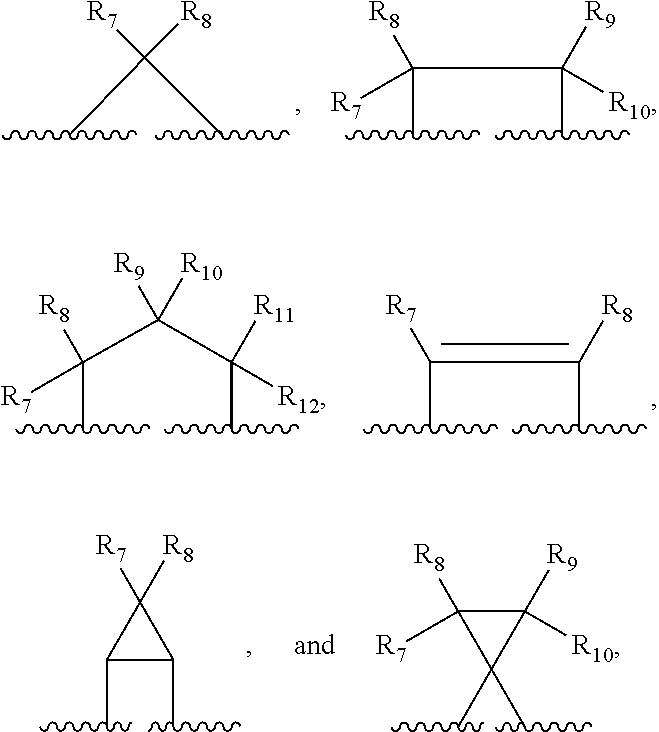Compounds, compositions and methods for treatment and prevention of orthopoxvirus infections and associated diseases
a technology of orthopoxvirus and composition, applied in the field of compound, composition and method for treating and preventing orthopoxvirus infections and associated diseases, can solve the problems of high mortality rate, high mortality rate, and inability to protect against recombinant forms of orthopoxvirus vaccination, and achieve the effect of robust cytopathic
- Summary
- Abstract
- Description
- Claims
- Application Information
AI Technical Summary
Benefits of technology
Problems solved by technology
Method used
Image
Examples
example 1
Preparation of 4-trifluoromethyl-N-(3,3a,4,4a,5,5a,6,6a-octahydro-1,3-dioxo-4,6-ethenocycloprop[f]isoindol-2(1H)-yl)-benzamide
a. Preparation of Compounds 1(a) and 1(b)
[0099]
[0100]A mixture of cycloheptatriene (5 g, 54.26 mmol) and maleic anhydride (6.13 g, 62.40 mmol) in xylenes (35 mL) was heated at reflux under argon overnight. The reaction was cooled to room temperature and a tan precipitate was collected by filtration and dried to give 2.94 grams (28%) of the desired product, which is a mixture of compounds 1(a) and 1(b). Compound 1(a) is normally predominant in this mixture and is at least 80% by weight. The purity of Compound 1(a) may be further enhanced by recrystallization if necessary. Compound 1(b), an isomer of compound 1(a) is normally less than 20% by weight and varies depending on the conditions of the reaction. Pure Compound 1(b) was obtained by concentrating the mother liquid to dryness and then subjecting the residue to column chromatography. Further purification ca...
examples 2-14
[0103]The compounds of Examples 2-14 were synthesized following the above mentioned general procedure for Example 1 using compound 1(a) and reacting it with the following hydrazides: isonicotinic hydrazide, 4-bromobenzoic hydrazide, 3-bromobenzoic hydrazide, 3-chlorobenzoic hydrazide, 2-bromobenzoic hydrazide, 2-chlorobenzoic hydrazide, 4-chlorobenzoic hydrazide, nicotinic hydrazide, 2-picolinyl hydrazide, 4-methoxybenzoic hydrazide, 4-nitrobenzoic hydrazide, 4-fluorobenzoic hydrazide, and 3-fluorobenzoic hydrazide.
example 15
Preparation of 4-bromo-N-(3,3a,4,4a,5,5a,6,6a-octahydro-1,3-dioxo-4,6-ethanocycloprop[f] isoindol-2(1H)-yl)-benzamide
a. Preparation of compound 15(a)
[0104]
[0105]To a solution of compound 1(a) (1 g, 5.26 mmol) in ethanol (20 mL) was added 10% palladium on activated carbon (100 mg, 10 wt %). The mixture was shaken on a Parr hydrogenator under an atmosphere of hydrogen at 50 psi for 3 hours. The mixture was filtered through a micron filter to remove the palladium, and the filtrate was concentrated to give 384 mg (38%) of the product as a white solid.
b. Preparation of 4-bromo-N-(3,3a,4,4a,5,5a,6,6a-octahydro-1,3-dioxo-4,6-ethanocycloprop[f]isoindol-2(1H)-yl)-benzamide
[0106]A mixture of compound 15(a) (350 mg, 1.82 mmol) and 4-bromobenzoic hydrazide (411 mg, 1.91 mmol) in ethanol (10 mL) was heated under argon for 48 hours. The solvent was removed by rotary evaporation. Purification by column chromatography on silica gel using 1 / 1 hexane / ethyl acetate as eluent provided 444 mg (63%) of t...
PUM
| Property | Measurement | Unit |
|---|---|---|
| weight | aaaaa | aaaaa |
| weight | aaaaa | aaaaa |
| particle size | aaaaa | aaaaa |
Abstract
Description
Claims
Application Information
 Login to View More
Login to View More - R&D
- Intellectual Property
- Life Sciences
- Materials
- Tech Scout
- Unparalleled Data Quality
- Higher Quality Content
- 60% Fewer Hallucinations
Browse by: Latest US Patents, China's latest patents, Technical Efficacy Thesaurus, Application Domain, Technology Topic, Popular Technical Reports.
© 2025 PatSnap. All rights reserved.Legal|Privacy policy|Modern Slavery Act Transparency Statement|Sitemap|About US| Contact US: help@patsnap.com



